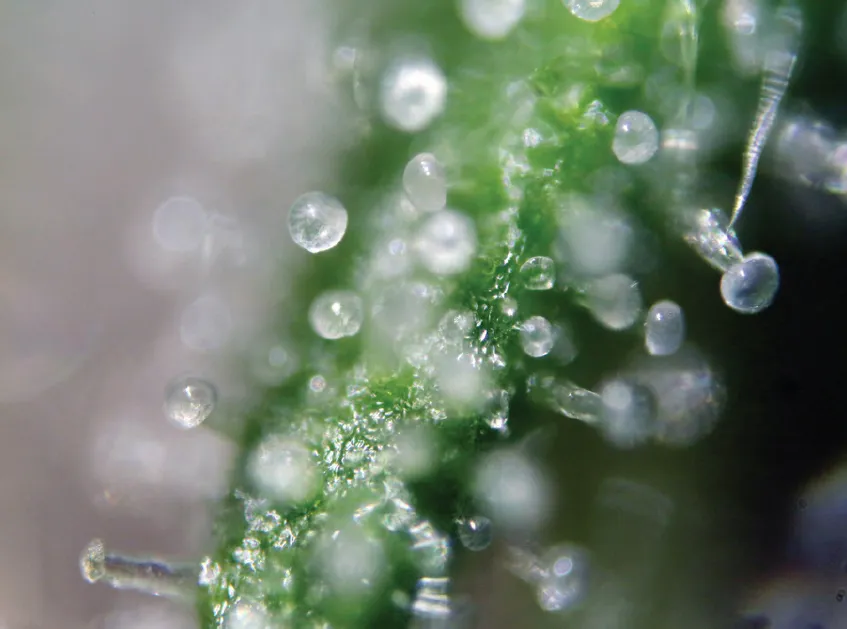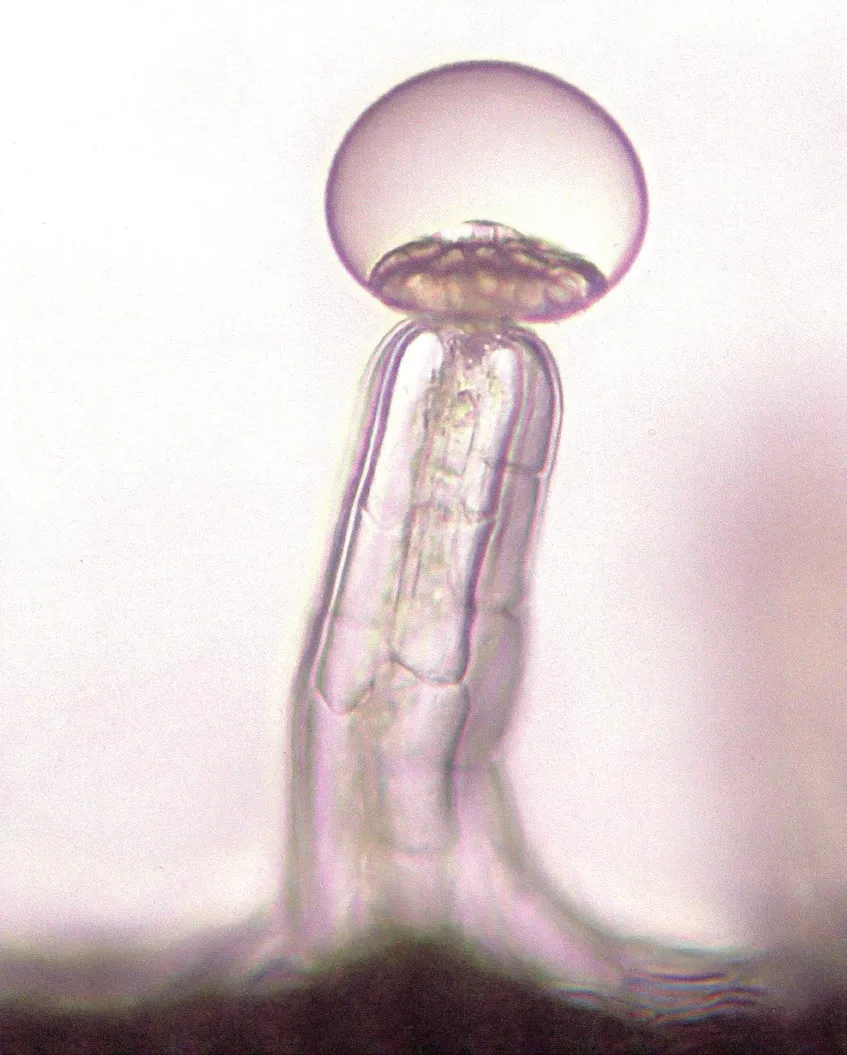![]()
Part 1
The Endocannabinoid System
In which we learn about the body’s endocannabinoid system (ECS). The ECS is how and why cannabis works in the body and brain to treat a range of health problems. We’ll explore the system’s ancient beginnings, its essential elements, and some of the most well known, so far, of the 565 cannabis constituents and their functions. And we’ll also explore the endocannabinoid system’s evolutionary emergence as an internal homeostatic regulator of nearly every function in the body and brain.
![]()
Chapter 1
Evolution, Revolution
To begin, for those who aren’t versed in the complexities of cannabis, the female plant is one whose flower is unlike any other, in more ways than one. The cannabis flower is a biochemical cooperative of working parts that together produce its more than 565 compounds, including the 120 cannabinoids that only cannabis can make.
Close-up of female cannabis plant in flowering phase (From Shutterstock by noxnorthys)
First, About Cannabis
On the female cannabis plant, mushroom-shaped glandular trichomes (try-komes) cover the plant’s main fan leaves and flowers. Resin spheres are on top of the trichome stalks.
Inside the spheres, the plant’s main products—cannabinoids (can-nab-in-noids) and other chemical constituents called terpenes (tur-peens) and flavonoids (flave-on-noids), and others—are manufactured. Terpenes arise in the essential oils of many plants, including pine and citrus trees. Flavonoids are plant chemicals in fruits and vegetables.
Female cannabis flower with microscopic view of trichomes (From Shutterstock by mikeledray)
Plant biologist Jonathan Page of Anandia Laboratories in Canada, speaking at the 2017 International Association for Cannabis as Medicine Conference in Cologne, Germany, said that cannabis resin, produced in the glandular trichomes of female inflorescences (a plant’s flower head, including stems, stalks, and flowers), is the main source of cannabinoids, which are unique to the cannabis plant.1
Drawing of a cannabis glandular trichome. (Courtesy Owen Smith)
Glandular trichomes also produce terpenes, which are responsible for much of the scent of cannabis flowers and contribute to the unique flavor qualities of cannabis products, J. K. Booth and colleagues wrote in a 2017 PLoS One paper.2
In the cannabis plant, Page said during his presentation, trichomes are specialized epidermal cells, and glandular trichomes produce cannabinoids, terpenes, flavonoids, and other constituents and store them. He added, “Within that glandular head there is a disc of secretory cells, and these are essentially the biochemical factory of the cannabis plant.” Page also noted that the secretory cells themselves are not photosynthetic—they don’t absorb light and make sugar.3
Trichome in profile: For this extreme close-up the trichome was temporarily mounted in glycerol and viewed in transmitted light. (Courtesy ©David Potter 2009)
“They’re just receiving nutrients and carbon sources up from the leaf or the flower and turning them into cannabinoids and terpenes,” the plant biologist said. “And then they’re pumped out of that secretory disk . . . and . . . into a secretory cavity that’s bordered by the cuticle—that’s sort of the skin of the plant—and they pump the cannabinoids and terpenes . . . into a cavity beneath the cuticle. So in essence,” he said, “[the glandular head is] a balloon full of bioactive metabolites.”4
To date, researchers have identified 120 cannabinoids (Dr. Mahmoud ElSohly, research professor and professor of pharmaceutics at the University of Mississippi, email communication November 9, 2018), but for now the two main cannabinoids are delta-9 tetrahydrocannabinol (THC, tetra-hydro-can-nab-in-all), the main psychoactive constituent in cannabis, and cannabidiol (CBD, cannab-ih-dye-all), the main nonpsychoactive constituent. Plant cannabinoids also are called phytocannabinoids, phyto (fight-o) being from the Greek word for “plant.”
Terpenes, according to Ethan Russo, MD, are essential oil components that form the largest group of plant chemicals. He is a board-certified neurologist and founder and chief executive officer of CannabisResearch.org.
More than 200 terpenes have been reported in the plant, Russo wrote, and they, not cannabinoids, produce the cannabis aroma. Terpenes like limonene and pinene in cannabis flowers protect the plant from insects, and bitter terpenes like beta-caryophyllene in the lower leaves protect it from grazing animals.5
Dr. Ethan Russo, a board-certified neurologist and founder and chief executive officer of credo-science.com. (Courtesy Cheryl Pellerin)
Genetics control terpene composition in the plant, and terpenes are pharmacologically versatile, Russo wrote, adding that they are lipophilic (dissolve in fats) and that they interact with cell membranes, neuron and muscle ion channels, neurotransmitter receptors, G protein-coupled receptors, enzymes, and more. Animal studies indicate that terpenoids (terpenes changed by drying the flowers) may be “relevant to the effects of cannabis.”6
In their 2017 Advances in Pharmacological Science publication,7 Russo and biochemist and medical cannabis safety expert Dr. Jahan Marcu wrote in detail about cannabis pharmacology and the contributions to cannabis’s physical and medical effects by some of the less-well-known phytocannabinoids and terpenoids.
“Analytical chemistry has revealed a rich and abundant ‘pharmacological treasure trove’ in the plant,” they wrote, quoting Professor Raphael Mechoulam’s 2005 British Journal of Pharmacology paper, “Plant cannabinoids: A neglected pharmacological treasure trove.” Mechoulam, an organic chemist and professor of medicinal chemistry at The Hebrew University of Jerusalem, is known worldwide as the grandfather of modern cannabis research.8
Mechoulam and colleagues in Israel kicked off the golden age of cannabis research, Russo and Marcu wrote, by isolating and synthesizing CBD, THC, and other phytocannabinoids, and Mechoulam’s work continues. Today, they added, “there are some 100 clinical studies and thousands of articles on the pharmacology and pharmacodynamics of cannabis and its influence on how humans eat, sleep, heal, and learn.”9
The Evolution Begins
No matter what you know about marijuana, there’s a bigger story—ancient and far-reaching. Ultimately it’s about the medical use of the flowering plant whose botanical name is cannabis, but this chapter shows what’s made it possible, for the past 5,000 years and right up to now, for healers and physicians to use cannabis, in all its forms, to treat in patients a broad and unlikely range of illnesses—maybe all of them.
What’s made it possible is the endocannabinoid system, the ancient biological system whose elements—endocannabinoids (cannabinoid-like molecules made in the body’s cells), enzymes, and receptors—work throughout the body and brain to balance health and disease. In a recent paper on cannabis pharmacology,10 Russo and Marcu called the ECS “perhaps the most significant human biological scientific discovery in the last 30 years.”
Among the three ma...





